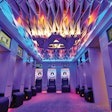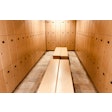![[Photo courtesy of HOK]](https://img.athleticbusiness.com/files/base/abmedia/all/image/2017/01/ab.Lockers117_feat.png?auto=format%2Ccompress&q=70&w=400)
On March 23, 2016, North Carolina governor Pat McRory signed into law the Public Facilities Privacy & Security Act, making his state the first in the nation to mandate that designated restrooms and locker rooms in government buildings (including those on public school and university campuses) be used by individuals based on the gender indicated on their birth certificate. Over the previous year, five additional states — Nevada, South Dakota, Tennessee, Texas and Wisconsin — had considered similar legislation to no effect (so far), and a so-called "bathroom bill" in Arizona circled the drain way back in 2013.
Collectively, these efforts succeeded in exposing another front in our country's culture wars, with advocates staking a commonsense high ground for individual safety, while opponents of the North Carolina law — officially titled "An Act to Provide for Single-Sex Multiple Occupancy Bathroom and Changing Facilities in Schools and Public Agencies and to Create Statewide Consistency in Regulation of Employment and Public Accommodations" — claim it represents some of the most anti-LGBT legislation ever passed.
That said, the push for privacy and security in locker room design predates this wave of public debate by a dozen years or more, according to sports and recreation facility architects. It started with the family changing room concept, most notably in aquatics centers. "We've been doing this kind of stuff for probably 15 years. It just wasn't a hot topic until our election cycle and North Carolina," says Hastings+Chivetta design principal Erik Kocher, who presented on the subject at a NIRSA-sponsored event in October. "It's become politicized in the past two years."
From AB: Designing Public Locker Rooms with an Eye on Privacy
"The first family locker room we did was maybe 2000, 2001, where we would have a room that could serve something other than a man with other men or a woman with other women," says Jack Patton, a principal at RDG Planning & Design. "So a lot of early toileting and showering facilities were built on the model of the family locker room, but that name in most places is no longer politically correct or otherwise accurate."
Today's concerns transcend determining the age at which a son should no longer accompany his mother into a women's locker room. Moreover, design isn't necessarily driven by which gender (if any) individuals identify as. It's more about creating comfortable environments for everyone. "Let's face it, we are all uncomfortable in public locker rooms, and if you are part of that small percentage of people who are not, then go ahead and bask in your self-confidence," says Chris Kastelic, senior vice president at Sink Combs Dethlefs. "For the rest of us, there are some key considerations surrounding current locker room design."
Here are six ways locker room design has become more accommodating:
![Personal shower and changing stall at the University of Nebraska-Lincoln's East Campus Recreation & Wellness Center [Photo courtesy of HOK]](https://img.athleticbusiness.com/files/base/abmedia/all/image/2017/01/ab.lockers1.png?auto=format%2Ccompress&fit=max&q=70&w=400) Personal shower and changing stall at the University of Nebraska-Lincoln's East Campus Recreation & Wellness Center [Photo courtesy of HOK]
Personal shower and changing stall at the University of Nebraska-Lincoln's East Campus Recreation & Wellness Center [Photo courtesy of HOK]
1. Private changing spaces within larger, gender-specific locker rooms
Individuals seeking privacy can do so — even in large, multiuser locker rooms — through the use of shower curtains, partitions or completely enclosed showering and changing compartments that combine personal wet and dry areas in 18 to 24 square feet (or 35 square feet minimum for ADA-compliant units).
"By adding three to four feet of space in front of the shower stall, and shifting the door from the 3-by-3 shower to enclose this entire 3-by-6 area, you have — very efficiently — created a private shower room," says Kastelic. "Compared to the days of gang showers, this small change feels downright luxurious."
"Curtains are especially appealing to those who are not comfortable in an open environment," says Colleen McKenna, a principal at CannonDesign, adding, "A more permanent solution is to build private change stalls similar to a toilet stall in each general locker room. Either way, private change rooms within a general-use locker room are on the rise. Owners need to keep in mind the additional square footage requirements to address the need for the increased privacy."
![Private showering and toileting space within the locker room setting at the University of North Carolina at Greensboro's Leonard J. Kaplan Center for Wellness [Photo courtesy of RDG Planning & Design]](https://img.athleticbusiness.com/files/base/abmedia/all/image/2017/01/ab.lockers2.png?auto=format%2Ccompress&fit=max&q=70&w=400) Private showering and toileting space within the locker room setting at the University of North Carolina at Greensboro's Leonard J. Kaplan Center for Wellness [Photo courtesy of RDG Planning & Design]
Private showering and toileting space within the locker room setting at the University of North Carolina at Greensboro's Leonard J. Kaplan Center for Wellness [Photo courtesy of RDG Planning & Design]
2. Separate cabana-style showering and changing rooms
A second option is to take the private showering and changing space completely out of the locker room. "Traditional locker rooms have been a barrier for numerous user groups — families with young children, guests with special needs, patrons with accessibility needs, and people who desire privacy when changing," says Carrie Heimmer, a designer at Barker Rinker Seacat Architecture. "By utilizing the cabana approach, many of these barriers are broken down."
The Provo Recreation Center opened in Utah in 2013 with 18 private changing cabanas — including 12 equipped with showers and toilets. Says Heimmer, "The flexible cabana strategies employed at Provo allow for an individual to use any of the cabanas without having to identify with a gender they may not be comfortable with."
3. Dry changing rooms
A third accommodation removes the wet areas from the changing space. Architects liken these spaces to the roughly five-square-foot dressing rooms found in most department stores, and generally like them for their cost efficiency. They're popular, too, with an increasing number of college students who prefer to shower at home after a workout. "For an individual who just wants to simply take off a sweaty shirt or a sweaty pair of shorts and put on the shirt and jeans he came in with, it doesn't have to take up a shower in order to do that," Patton says.
![Daylockers within the Aggie Recreation Center, Utah State University [Photo courtesy of RDG Planning & Design]](https://img.athleticbusiness.com/files/base/abmedia/all/image/2017/01/ab.lockers3.png?auto=format%2Ccompress&fit=max&q=70&w=400) Daylockers within the Aggie Recreation Center, Utah State University [Photo courtesy of RDG Planning & Design]
Daylockers within the Aggie Recreation Center, Utah State University [Photo courtesy of RDG Planning & Design]
4. Day-use lockers
Gender-specific, multiuser locker rooms remain a popular option for facilities that count on locker rental fees for revenue. The University of Wisconsin, for example, will have 1,300 total lockers in the men's and women's locker rooms in a newly renovated recreation center under construction on its Madison campus, but 350 day-use lockers will be strategically placed near various activity areas. "Lockers are expensive. You don't want to buy a bunch that never get used," says Emily Ostertag, lead interior designer for HOK's recreation and wellness studio. "If you're providing day lockers in the right locations, then you don't have to have as many lockers in the locker room."
What do you call it?As large public locker rooms have made way for individual private changing rooms, the labels placed on these spaces have morphed, as well. While some facilities now eschew labels altogether, here's a list of what's been seen outside changing room doors so far: • Family Changing Room |
Independent of the locker room, offering a variety of day-use lockers — large enough to store a college student's backpack and winter outerwear or adequately downsized for keys and a phone — provides gender-neutrality in its own way. "Designing secure lockers outside of the gender-specific locker rooms provides access to locker contents by any family members at any time," Heimmer says. "This allows for mom to be swimming while her son is participating in a class. When his class is over, the son can access his swimming suit out of the locker and join mom in the pool."
5. Floorplan flexibility
Like day-use lockers, personal changing rooms allow for far greater facility design options compared to larger gender-specific locker rooms. "If we have 16 cabanas, we now have the ability to put four over here by the pool, four over here by the entrance, four by the gymnasium," says Patton. "We do have a little bit more flexibility to dissect these into multiple satellite locations."
Care can be taken to minimize plumbing infrastructure and expense. "If we stack these lockers on three different floors right above each other, they're really just as close as they would have been if they were on the same level side by side," Patton says.
The proximity of private changing rooms to more traditional locker rooms can be an important consideration, as well. "Wisconsin was kind of cool because the rec staff met with members of the LGBT group and talked about their preference," Ostertag says. "They were unsure if the LGBT users wanted to be a little bit more private and away from the main rec locker rooms or if they wanted to be included and very close to the locker rooms, and they actually preferred to be closer."
![The family locker room within The Provo Recreation Center in Utah. [Photo courtesy of Barker RInker Seacat]](https://img.athleticbusiness.com/files/base/abmedia/all/image/2017/01/ab.lockers4.png?auto=format%2Ccompress&fit=max&q=70&w=400) The family locker room within The Provo Recreation Center in Utah. [Photo courtesy of Barker RInker Seacat]
The family locker room within The Provo Recreation Center in Utah. [Photo courtesy of Barker RInker Seacat]
Privacy can even extend to the act of entering these various spaces. At the University of Michigan, the nation's first campus facility dedicated to recreation (in 1928) has been renovated to include a personal room, accessible — as are the entrances to the men's and women's locker rooms that flank it — from a common area off the circulation path. That way, a user's ultimate destination isn't immediately obvious to onlookers who might label that individual based on changing preferences. Says Patton, "You come off the normal traffic path and you're headed toward those locker spaces in this anteroom, and then you make a decision of going straight ahead, or turning left or right."
![Public locker room at the University of Iowa's Campus Recreation and Wellness Center [Photo courtesy of RDG Planning & Design]](https://img.athleticbusiness.com/files/base/abmedia/all/image/2017/01/ab.lockers5.png?auto=format%2Ccompress&fit=max&q=70&w=400) Public locker room at the University of Iowa's Campus Recreation and Wellness Center [Photo courtesy of RDG Planning & Design]
Public locker room at the University of Iowa's Campus Recreation and Wellness Center [Photo courtesy of RDG Planning & Design]
6. Cost
Gang-style public locker rooms will always be the more efficient investment compared to individual shower-and-change rooms, and the cost disparity becomes more pronounced the more users a facility intends to serve. Once a facility gets beyond two to five private shower rooms, construction efficiency starts to fall precipitously.
"You walk into a convention center bathroom, there are 15 urinals and 20 toilets. That's very efficient," Kocher says. "Imagine exploding those into 20 individual distinct bathrooms. That's when it gets inefficient. It takes more square footage. On top of that, each space inherently just costs more, because in a public restroom the ratio between toilets and sinks is different than in a private restroom, where it's a one-to-one ratio. So you buy more sinks, more ADA handrails. You buy soap and paper towel dispensers for every sink versus dispensers that might be shared between three or four."
It's never been fiscally smart to oversize a locker room, but specifying the number of private changing spaces can be particularly challenging. Building code dictates baseline toilet fixture requirements (and a minimum number of showers if a pool or spa is part of the program), but the facility's peak usage must be adequately met. "There's absolutely zero data out there that answers the question, 'Well, how many do you need?' " Kocher says. "If you're building this brand-new, state-of-the-art, 100,000-square-foot rec center, how are you going to guess right? Plumbing code drives a little bit of it. Clearly there is a cost implication, as well."
The gender-neutral nature of private changing rooms eliminates some guesswork, at least when it comes to planning for the fluid gender breakdown of any given population. Says Patton, "It allows even a change of demographics to still be handled in the building acceptably."
BREAKING UP THE GANG FOR GOOD?
For many architects, specification of traditional locker room gang showers has slowed to a trickle — even in varsity sports facilities. "I would say in the past 15 years, for every 95 showers we've designed, at most only five of those have been gang style," Patton says. "We've really moved to very privatized showering areas."
"Every guest has a different need when using a locker room," Heimmer says. "Uses range from guests who come dressed and are looking for a secure place to store their wallet and phone, to the pool user who needs a large accessible area to change, shower and prepare themselves for a day of work. Providing users with flexibility to have a personalized locker room experience that meets their needs is a key consideration for locker room design."
"It's all about inclusivity," says Ostertag. "If you have an all-gender locker room, it's really for those with disabilities, those with families and children, those who are transgender. It's really about making an area that's inclusive for everyone. And that's just what we try to achieve."
Modesty rules in 2017, no matter the user, according to Kocher. "You can say this is being driven to the forefront by the topic of providing transgender spaces, but the reality is everybody has some sense of privacy or level of shyness," he says. "If a person has the opportunity to use one space versus another, they're going to always migrate to the more private than the more public."
This article originally appeared in the January | February 2017 issue of Athletic Business with the title "Public locker room design in the age of privacy." As the print version of this article went to press, it was expected that the North Carolina legislation would be repealed in late December at the request of McRory's gubernatorial successor. However, that did not happen, as the print version suggests. This version has been updated to accurately reflect the current status of the North Carolina law. Athletic Business is a free magazine for professionals in the athletic, fitness and recreation industry. Click here to subscribe.





































